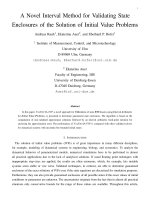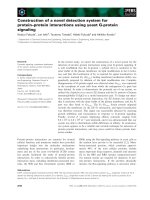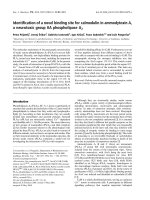Tissue Penetration of a novel spectinamide antibiotic for the treatment of tuberculosis
Bạn đang xem bản rút gọn của tài liệu. Xem và tải ngay bản đầy đủ của tài liệu tại đây (344.18 KB, 4 trang )
The AAPS Journal, Vol. 18, No. 3, May 2016 ( # 2016)
DOI: 10.1208/s12248-016-9900-7
Brief/Technical Note
Tissue Penetration of a Novel Spectinamide Antibiotic for the Treatment
of Tuberculosis
Dora Babu Madhura,1 Ashit Trivedi,1 Jiuyu Liu,2 Vincent A. Boyd,2 Cynthia Jeffries,2 Vivian Loveless,1
Richard E. Lee,2 and Bernd Meibohm1,3
Received 18 August 2015; accepted 2 March 2016; published online 16 March 2016
The in vivo biodistribution and pharmacokinetics of 1329, a novel spectinamide
Abstract.
antibiotic with anti-tubercular activity, were studied during intravenous administration of an
tritium-labeled compound for nine consecutive, 12-hourly doses to rats. Serial blood samples
were collected after the first and the eighth dose, and major organs and tissues were collected
1 h after the ninth dose. Urinary and fecal excretion was monitored throughout the dosing
period. Radioactivity in the collected samples was assessed by scintillation counting. During
the course of treatment, 86.6% of the administered radioactivity was recovered in urine,
feces, organs, and muscle tissue. Urinary excretion was the major route of elimination, with
70% of radioactivity recovered from urine and 12.6% from feces. The time profiles of
radioactivity in serum after the first and the eighth dose were identical for the first 2 h postdose, with similar Cmax (3.39 vs. 3.55 mCi/L) and AUC0−τ (5.08 vs. 5.17 mCi • h/L),
indicating no substantial accumulation of 1329 during multiple dosing. Radioactivity in major
target organs for pulmonary tuberculosis infection, the lungs and spleen, was 2.79- and 3.06fold higher than in the blood. Similarly, the intracellular uptake of 1329 into macrophages
was sixfold higher than for streptomycin. Overall, these observations suggest biodistribution
properties favorable for targeting pulmonary tuberculosis infections.
KEYWORDS: biodistribution; mass balance; pharmacokinetics; spectinamide; tuberculosis.
identify potential toxicity and safety concerns of novel drug
candidates (2,3).
INTRODUCTION
Spectinamides are novel amide derivatives of the antibiotic
spectinomycin synthesized by chemical modification on the 3′
position of spectinomycin (Fig. 1). We have previously demonstrated that spectinamides exhibit potent anti-tuberculosis activity
in vitro and in several in vivo rodent models of Mycobacterium
tuberculosis (MTB) infection that is a product of high affinity for
the mycobacterial ribosome and avoidance of efflux by the MTB
efflux pump Rv1258c (1). In the current study, we investigated the
biodistribution, tissue accumulation, mass balance, and pharmacokinetics of a radiolabeled version of one of our spectinamide lead
compounds 1329, designated as 3H-1329, as vital information to
Electronic supplementary material The online version of this article
(doi:10.1208/s12248-016-9900-7) contains supplementary material,
which is available to authorized users.
1
Department of Pharmaceutical Sciences, University of Tennessee
Health Science Center, 881 Madison Ave, Suite 444, Memphis,
Tennessee 38163, USA.
2
Department of Chemical Biology and Therapeutics, St. Jude
Children’s Research Hospital, Memphis, Tennessee 38105, USA.
3
To whom correspondence should be addressed. (e-mail:
)
1550-7416/16/0300-0788/0 # 2016 American Association of Pharmaceutical Scientists
MATERIALS AND METHODS
Biodistribution Study of 3H-1329
Radiolabeling of 1329 [3′-Dihydro-3′-deoxy-3′(R)-(pyridin2yl) acetylamino spectinomycin trihydrobromide] was performed
as described in the Online Supplementary Material. Catheterized
male Sprague-Dawley rats (n = 6 plus one control; Harlan Bioscience, Indianapolis, IN) weighing 229 to 247 g (average 237 ± 7 g)
were housed in individual metabolic cages in a temperature- and
air-controlled room and kept on a 12-h light/dark cycle with access
to food and water ad libitum. The animals were administered 3H1329 intravenously (IV) via a femoral vein catheter at a dose of
0.9 mg/kg body weight (0.87 mCi/kg) every 12 h for 4.5 days (a total
of nine doses for each animal). The control rat received vehicle
(normal saline) only. Serial blood samples (approx. 250 μL) were
collected from a jugular vein catheter at 0 (pre-dose), 0.25, 2, 8, and
12 h after the first dose and at 0 (before eighth dose), 0.25, 0.5, 1, 2,
4, 6, and 12 h after the eighth dose. Serum was separated from
blood after clotting at room temperature by centrifugation (10,000g
for 10 min). Urine and feces specimens were collected at 0 h (predose) and every 12 h after dosing up to the end of the study. One
788
Biodistribution and Pharmacokinetics of Spectinamides
789
Fig. 1. Structure of spectinamide anti-tubercular agents. Spectinamide
1329, developed from the parent antibiotic spectinomycin
hour after the administration of the ninth dose (on day 5), the
animals were euthanized, total blood was collected by cardiac
puncture, and all major organs and tissues including the liver,
kidneys, spleen, lung, heart, brain, and thigh muscle tissue were
collected. All samples were stored at −80°C until analysis. Total
volume of blood, urine, total weight of the organs, muscle (4), and
feces was noted for the calculation of mass balance.
Macrophage Uptake Assay
Analysis of Biologic Samples for 3H-1329
Tritium activity (3H) in the specimens (in terms of
disintegrations per minute (DPM)) was determined with a daily
calibrated Tri-carb 2800 TR liquid scintillation analyzer
(PerkinElmer, Waltham, MA) after mixing samples with liquid
scintillation cocktail as described in the Online Supplemental
Material. The energy window was set from 0 to 20 keV. In order
to reduce the luminescence originating from the samples, a 10-min
pre-count delay was used. Samples were counted in the luminescence correction mode with three replicates and a 1-min counting
time. The average counting efficiency for 3H is 65.45%.
Table I. Tissue Distribution and Recovery
Sample/
organ
Administration
Total amount
administered
Recovery
Blooda
Liver
Kidney
Lung
Spleen
Heart
Brain
Muscle
Urinea
Fecesb
Total amount
recovered
Relative
amount of
radioactivity
[μCi/g tissue]
Total amount
of radioactivity
[μCi]
Fig. 2. Urinary excretion. Amount of radioactivity excreted in urine
after each dosing interval (0.9 mg/kg 3H-1329, BID for 4.5 days).
Values are expressed as mean ± SD
% of radioactivity
recovered
Macrophages are a common reservoir for MTB and thus
effective anti-mycobacterials need to penetrate well into the
intracellular space of macrophages (5). A macrophage uptake
assay for 1329 was performed using the murine macrophage cell
line J774A.1 (ATCC, Manassas, VA). The cells were cultured in
Dulbecco’s Modified Eagle’s medium (DMEM; Gibco, USA) with
10% fetal bovine serum (Sigma-Aldrich, USA) at 37°C, 5% CO2
and allowed to grow until 60–80% confluence in a six-well plate
(each plate representing an individual time point and concentration). After exchanging the media for DMEM containing a final
1329 concentration of either 25 or 100 μg/mL, plates were
incubated and the media containing test compound was aspirated
at different time point (0.5, 1, 4, 8, and 24 h). The cells were washed
with ice-cold Dulbecco’s phosphate-buffered saline, suspended in
1 mL water and sonicated for 2 min. The cell suspension was
centrifuged for 5 min at 10,000 rpm and the supernatant collected
was used to determine the drug uptake using an LC-MS/MS assay
as previously described (1). The drug uptake was expressed in
1432 (3.44)
0.240 (12.2)
1.19 (13.7)
7.92 (8.98)
0.635 (9.35)
0.688 (11.5)
0.224 (9.32)
0.104 (18.1)
0.228 (21.8)
17.9 (21.2)
5.91 (39.6)
3.47
11.4
16.4
0.805
0.658
0.219
0.160
24.7
1003
181
1242
0.242 (26.8)
0.796 (5.99)
1.15 (10.9)
0.056 (12.1)
0.046 (13.8)
0.015 (24.9)
0.011 (39.6)
1.72 (34.9)
70.0 (2.99)
12.6 (29.8)
86.6 (5.09)
Recovery of radioactivity following IV administration of 3 H-1329
(0.9 mg/kg, BID for 4.5 days) in rats. All values are expressed as
mean (%CV)
a
In μCi/mL
b
In μCi/g feces
Fig. 3. Tissue penetration of 3H-1329. Fold difference in tissue
distribution of radioactivity compared to amount in whole blood
(after normalizing the distributions to μCi/mL or μCi/mg of blood or
tissue). Values are expressed as mean ± SD. The horizontal dotted line
indicates the reference value
Madhura et al.
790
significant when p < 0.05 by one-way ANOVA followed by
Tukey’s multiple range test.
RESULTS AND DISCUSSION
Mass Balance
Fig. 4. Comparison of single and multiple dose pharmacokinetics.
Average (±SD) serum concentration-time profiles of radioactivity
after the first dose and eighth dose during multiple dosing with
0.9 mg/kg 3H-1329 given intravenously every 12 h
terms of μg/mg of protein, as determined with the Pierce BCA
assay kit (Thermo Fisher Scientific, Waltham, MA).
Data Analysis
The biodistribution of 3H-1329 in blood, serum, organs,
muscle, urine, and feces was calculated in terms of 3H activity
(μCi or mCi of 3H) from the analyzed DPM using standard
conversion provided by PerkinElmer (2.22 × 106 DPM equal
to 1 μCi of 3H) and is expressed as μCi of 3H-1329 activity per
gram or milliliter of sample or as percent radioactivity
recovered relative to the total amount of 3H-1329 activity
administered.
Serum 3 H-1329 activity versus time profiles were
analyzed by standard non-compartmental pharmacokinetic
analysis using Phoenix WinNonlin 6.2 (Certara, Mountain
View, CA) (6). Statistical differences were considered
During the course of nine doses of 0.9 mg/kg 3H-1329
administered intravenously every 12 h, a total of 86.6% of the
administered radioactivity was recovered in urine, feces,
blood, muscle, and organs (Table I). Mass balance analysis
exhibited that 1 h after the ninth dose approximately 70% of
the administered 3H-1329 activity had been recovered in
urine and 12.6% in feces, while all the major organs, muscle
tissue and whole blood contained only 4.0% of the
radioactivity. Thus, in the present study, 86.6% of the
administered radioactivity was recovered in urine, feces,
organs, and tissues, which is in good agreement with
recoveries in other mass balance studies (7–9). The amount
of radioactivity excreted in urine after each dosing interval is
nearly identical, ranging from 119.3 to 138.9 μCi (Fig. 2),
suggesting that there is no substantial accumulation of drug in
the body during multiple dosing.
Previous pharmacokinetic studies with cold 1329 have
shown that 1329 is stable towards hepatic microsomal phase I
metabolism, is only bound to 29% to serum proteins, and is
excreted to 46% in unchanged form in the urine (1,10). The
role of renal excretion as major route of elimination is further
supported by the mass balance data.
Tissue Distribution
One hour after the ninth dose, the distribution of radioactivity
to major organs (liver, kidney, brain, lung, heart, and spleen) and
muscle was analyzed to evaluate the tissue distribution, penetration, and accumulation of 3H-1329 and its labeled metabolites.
Relative and absolute radioactivity for each organ and tissue are
presented in Table I. The fold difference in amount of radioactivity
per milligram or milliliter of tissue relative to whole blood was used
Fig. 5. Macrophage cellular uptake. a Average (±SEM) concentration of drug uptake in
macrophages after 24 h of incubation at drug concentrations of 25 and 100 μg/mL (N = 6). b Fold
difference in cellular uptake of 1329 and spectinomycin as compared to streptomycin at both
concentration levels after 24 h of incubation. The horizontal dashed line specifies the reference line
Biodistribution and Pharmacokinetics of Spectinamides
791
as a measure of tissue penetration (Fig. 3). 3H-1329 activity in the
lungs and spleen was 2.79- and 3.06-fold higher compared to whole
blood, suggesting good tissue penetration of 3H-1329 into those key
organs with the highest bacterial burden in pulmonary tuberculosis
as most common form of MTB infection. In comparison,
penetration of 3H-1329 was less than onefold to other organs such
as the heart and brain.
(ALSAC). We thank Tom Mohaupt, Jennings Payne, Kellen
Thuo, and Warner Turner (Radiation Safety Division, St. Jude
Children’s Research Hospital, Memphis, TN) for their help in
determining the total and specific activity of the radiolabeled
compound. We thank Dr. Feng Yin and Dr. James T. Dalton (GTx
Inc., Memphis, TN) for the opportunity to use their sample
oxidation equipment.
Pharmacokinetic Profile of Radioactivity in Serum
COMPLIANCE WITH ETHICAL STANDARDS
A comparison of the time profiles of radioactivity after
administration of the first dose (day 1) and eighth dose (day 5)
exhibited similar values for the average [%CV] systemic
exposure measures maximum concentration Cmax (3.39 [7.4] vs.
3.55 [28.9] mCi/L) and area-under-the-curve during one dosing
interval AUC 0-τ (5.08 [6.8] vs. 5.17 [20.8] mCi · h/L),
suggesting an effective half-life of 2.05 h and the absence of
any substantial drug accumulation in serum (11,12). While the
concentration-time profiles are superimposable for the first 2 h
after the first and eighth dose, respectively, concentrations of the
radiosignal were elevated by approximately 50% beyond 2 h
post-dose (Fig. 4). A potential formation of circulating metabolites of 3H-1329 as cause for this elevation would be in line with
the renal excretion data. Alternatively, this could be explained by
the in vivo formation of tritiated water which has been reported
to follow a half-life of 85–98 h in rats (7). Tritium exchange and
the potential formation of tritiated water in vivo is recognized as
a potential limitation for the use of tritiated compounds for drug
disposition studies (7), although our in vitro data did not show
any tritium exchange for 3H-1329.
All animal experiments were conducted in accordance
with the Animal Welfare Act and the Public Health Service
Policy on Humane Care and Use of Laboratory Animals. The
study protocol was approved by the Institutional Animal
Care and Use Committee and the Radiation Safety Committee of the University of Tennessee Health Science Center.
Macrophage Uptake
Intracellular uptake into macrophages is a prerequisite for
antibiotic activity against MTB residing in infected macrophages
(5). MTB continues to replicate after it gets ingested by
macrophages (13). Hence, it is essential to determine the
penetration of anti-tuberculosis agents into the intracellular
space of macrophages. 1329 showed a significantly higher
penetration into macrophages as compared to spectinomycin,
the parent compound of 1329, and streptomycin, an aminoglycoside antibiotic that is used as second-line agent to treat
tuberculosis. As shown in Fig. 5, 1329 has a sixfold higher uptake
than streptomycin and a 2.2-fold higher uptake than spectinomycin, which is in line with the good tissue penetration on 1329
observed in the mass balance study.
CONCLUSION
Spectinamide 1329 has exhibited properties favorable for
targeting pulmonary MTB infection in these initial
biodistribution studies. Further, more definitive drug disposition
and biodistribution studies with isotopes such as 14C will need to
corroborate and expand the observations of this report.
ACKNOWLEDGMENTS
This research was supported by grant R01AI090810 by the
National Institute of Allergy and Infectious Diseases and grant
S10OD016226, Office of the Director, National Institutes of Health
and the American Lebanese Syrian Associated Charities
Conflict of Interest J.L., R.E.L., and B.M. disclose intellectual
property rights ownership associated with the spectinamide series.
REFERENCES
1. Lee RE, Hurdle JG, Liu J, Bruhn DF, Matt T, Scherman M, et al.
Spectinamides: a new class of semisynthetic antituberculosis
agents that overcome native drug efflux. Nat Med.
2014;20(2):152–8. doi:10.1038/nm.3458.
2. Meibohm B, Derendorf H. Pharmacokinetic/pharmacodynamic studies
in drug product development. J Pharm Sci. 2002;91(1):18–31.
3. Mdluli K, Kaneko T, Upton A. The tuberculosis drug discovery
and development pipeline and emerging drug targets. Cold
Spring Harb Perspect Med. 2015;5(6). doi: 10.1101/
cshperspect.a021154.
4. Usynin IF, Khar’kovsky AV, Balitskaya NI, Panin LE. Gadolinium chloride-induced Kupffer cell blockade increases uptake of
oxidized low-density lipoproteins by rat heart and aorta.
Biochemistry (Mosc). 1999;64(6):620–4.
5. Pieters J. Mycobacterium tuberculosis and the macrophage:
maintaining a balance. Cell Host Microbe. 2008;3(6):399–407.
doi:10.1016/j.chom.2008.05.006.
6. Muir KT, Gomeni RO. Non-compartmental analysis. In: Bonate
PL, Howard DR, editors. Pharmacokinetics in drug development: clinical study design and analysis, vol. 1. Arlington: AAPS
Press; 2004. p. 235–58.
7. Shaffer CL, Gunduz M, Thornburgh BA, Fate GD. Using a
tritiated compound to elucidate its preclinical metabolic and
excretory pathways in vivo: exploring tritium exchange risk.
Drug Metab Dispos: Biol Fate Chem. 2006;34(9):1615–23.
doi:10.1124/dmd.106.010934.
8. Yang S, Zhang Q, Chen J, Han D, Zhao D, Chen X.
Pharmacokinetics and disposition study of calf thymus DNA in
rats by applying 3H-labeling method. J Pharm Biomed Anal.
2012;64-65:35–9. doi:10.1016/j.jpba.2012.02.012.
9. Roffey SJ, Obach RS, Gedge JI, Smith DA. What is the
objective of the mass balance study? A retrospective analysis
of data in animal and human excretion studies employing
radiolabeled drugs. Drug Metab Rev. 2007;39(1):17–43.
doi:10.1080/03602530600952172.
10. Madhura DB, Trivedi A, Rathi C, Liu J, Lee RE, Meibohm B.
Pharmacokinetic evaluation of novel spectinamides. AAPS J.
2012;14(S2):W5350.
11. Wagner JG. Drug accumulation. J Clin Pharmacol. 1967;7(2):84–8.
12. Boxenbaum H, Battle M. Effective half-life in clinical pharmacology. J Clin Pharmacol. 1995;35(8):763–6.
13. Knechel NA. Tuberculosis: pathophysiology, clinical features,
and diagnosis. Crit Care Nurse. 2009;29(2):34–43. doi:10.4037/
ccn2009968.









